Two-Stage Transformer–Customer Relationship Identification Strategy for Low-Voltage Distribution Grid Using Physics-Guided Graph Attention Network
Abstract
1. Introduction
- (1)
- A novel two-stage identification strategy integrating PGAT for transformer–customer relationships in LVDG. Initial identification is achieved through clustering algorithms, followed by graph-learning-based refinement of transformer–customer mappings. This method provides a cost-effective, noise-resistant, and highly implementable solution for relationship identification.
- (2)
- A voltage fluctuation-based MPAA algorithm is developed for data compression and denoising of raw measurements. Time-series weighted aggregation using voltage fluctuation intensity metrics (considering both transient and steady-state fluctuations) preserves crucial voltage correlation features. This method resolves the “feature submergence” issue in conventional methods while improving computational efficiency.
- (3)
- A PGAT training paradigm is proposed. The loss function design incorporates customer power source uniqueness, transformer capacity constraints, and real-time power balance between customers and transformers. This ensures the learning paradigm adheres to grid topology and electrical characteristic constraints. Efficient learning of transformer–customer electrical information and connection patterns is achieved, significantly improving identification accuracy.
2. Transformer–Customer Relationship Identification Architecture for LVDG
3. Preliminary Identification of Transformer–Customer Relationships Using MPAA-K-Means
3.1. MPAA Algorithm Based on Voltage Fluctuation
3.2. Preliminary Identification of Transformer–Customer Relationships Using Mpaa-K-Means
4. Refined Identification Using PGAT
4.1. Graph Structured Representation of the Transformer–Customer Relationships Based on Preliminary Identification Results
4.2. Transformer–Customer Feature Extraction and Connection Refinement Using Modified GAT
- (1)
- Feature fusion based on GAT
- (2)
- Proposed physics-guided loss function design paradigm
- (a)
- Single power supply operation for customers
- (b)
- Transformer capacity constraint
- (c)
- Real-time power balance between transformers and customers
5. Two-Stage Transformer–Customer Relationship Identification Process for LVDG Using PGAT
6. Case Studies
6.1. Case Configuration
6.2. Analysis of the Model Training Process
6.3. Results of Transformer–Customer Relationship Identification
6.4. Comparison of Different Methods
6.5. Analysis of Model Sensitivity
7. Conclusions
- (1)
- The proposed two-stage transformer–customer relationship identification strategy achieves preliminary identification through the MPAA-K-means algorithm. The PGAT model further learns the electrical coupling relationships between transformers and customers, incorporating grid physical constraints for refined identification. The strategy achieves a final identification accuracy of 99.49%, demonstrating efficient learning and precise identification of transformer–customer association patterns.
- (2)
- Comparative experiments validate that the MPAA algorithm effectively compresses and denoises measurement data while preserving voltage correlation features, significantly improving K-means clustering stability. The proposed PGAT model embeds the electrical constraints of LVDG into the training paradigm. The proposed model achieves 5.37% higher identification accuracy compared to conventional GAT models.
- (3)
- The proposed two-stage strategy demonstrates superior noise resistance performance. The attention mechanism dynamically adjusts node weights to effectively address challenges posed by AMI measurement noise. For every 4% increase in noise, the identification accuracy reduces by only 2.09% on average. This provides an effective solution for accurate and reliable transformer–customer relationship identification in practical grid operations.
Author Contributions
Funding
Data Availability Statement
Conflicts of Interest
References
- Fang, L.; Pengwah, A.B.; Andrew, L.L.; Razzaghi, R.; Muñoz, M.A. Three-phase voltage sensitivity estimation and its application to topology identification in low-voltage distribution networks. Int. J. Electr. Power Energy Syst. 2024, 158, 109949. [Google Scholar] [CrossRef]
- Wu, W.; Zhou, Y.; Li, P.; Sun, G.; Lin, H.; Xu, G. Survey on negative line loss rate of transformer region: Rectification measures and challenges. AIP Adv. 2020, 10, 045124. [Google Scholar] [CrossRef]
- Ashok Babu, P.; Mazher Iqbal, J.L.; Siva Priyanka, S.; Jithender Reddy, M.; Sunil Kumar, G.; Ayyasamy, R. Power control and optimization for power loss reduction using deep learning in microgrid systems. Electr. Power Compon. Syst. 2024, 52, 219–232. [Google Scholar] [CrossRef]
- Wang, Y.; Xie, L.; Liu, F.; Yu, K.; Zeng, X.; Bi, L.; Tang, X. Fault location method for distribution network Considering distortion of traveling wavefronts. Int. J. Electr. Power Energy Syst. 2024, 159, 110065. [Google Scholar] [CrossRef]
- Wang, X.; Guo, Q.; Tu, C.; Che, L.; Xu, Z.; Xiao, F.; Li, T.; Chen, L. A Comprehensive Control Strategy for F-SOP Considering Three-Phase Imbalance and Economic Operation in ISLDN. IEEE Trans. Sustain. Energy 2024, 16, 149–159. [Google Scholar] [CrossRef]
- Al Khafaf, N.; Rezaei, A.A.; Amani, A.M.; Jalili, M.; McGrath, B.; Meegahapola, L.; Vahidnia, A. Impact of battery storage on residential energy consumption: An Australian case study based on smart meter data. Renew. Energy 2022, 182, 390–400. [Google Scholar] [CrossRef]
- Chen, Z.; Amani, A.M.; Yu, X.; Jalili, M. Control and optimisation of power grids using smart meter data: A review. Sensors 2023, 23, 2118. [Google Scholar] [CrossRef]
- Ge, H.; Xu, B.; Zhang, X.; Bi, Y. Low-voltage overhead lines topology identification method based on high-frequency signal injection. Arch. Electr. Eng. 2021, 70, 791–800. [Google Scholar]
- Byun, H.J.; Zheng, Y.P.; Choi, S.J.; Shon, S.G. New identification method for power transformer and phase in distribution systems. Appl. Mech. Mater. 2018, 878, 291–295. [Google Scholar] [CrossRef]
- von Meier, A.; Stewart, E.; McEachern, A.; Andersen, M.; Mehrmanesh, L. Precision micro-synchrophasors for distribution systems: A summary of applications. IEEE Trans. Smart Grid 2017, 8, 2926–2936. [Google Scholar] [CrossRef]
- Blakely, L.; Reno, M.J. Identification and correction of errors in pairing AMI meters and transformers. In Proceedings of the 2021 IEEE Power and Energy Conference at Illinois (PECI), Urbana, IL, USA, 1–2 April 2021; IEEE: New York, NY, USA, 2021; pp. 1–8. [Google Scholar]
- Zhou, L.; Wen, F.; Yang, X.; Zhong, Y. User-transformer connectivity relationship identification based on knowledge-driven approaches. IEEE Access 2022, 10, 54358–54371. [Google Scholar] [CrossRef]
- Liu, J.; Zang, W.; Lu, Y.; Zhang, Y.; Cong, R. Transformer-customer Relationship and Phase Identification Method of Low-voltage Distribution Networks Based on Critical Time Segments. J. Phys. Conf. Ser. 2023, 2666, 012010. [Google Scholar]
- Song, J.; Jiang, Y.; Wei, Y.; Sheng, Z.; Song, X. Consumer-Transformer Relationship Identification Based on Improved FCM Clustering. In Proceedings of the 2024 5th International Conference on Clean Energy and Electric Power Engineering (ICCEPE), Yangzhou, China, 9–11 August 2024; IEEE: New York, NY, USA, 2024; pp. 863–868. [Google Scholar]
- Al Khafaf, N.; Song, H.; McGrath, B.; Jalili, M. Identification of low voltage distribution transformer–customer connectivity based on unsupervised learning. Energy Rep. 2023, 9, 72–79. [Google Scholar] [CrossRef]
- Ren, H.N.; Wang, Y.; Li, J.; Cai, H.D.; Wei, W. Dynamic identification of customer-transformer relationship based on Bayesian inference and spectral clustering. Power Syst. Prot. Control. 2023, 51, 1–10. [Google Scholar]
- Zhu, Y.; Yang, X.; Yan, H. Data-driven identification of household-transformer relationships in power distribution networks using Hausdorff similarity assessment. Front. Energy Res. 2023, 11, 1233827. [Google Scholar] [CrossRef]
- Huang, L.; Zhou, G.; Zeng, Y.; Zhang, J.; Feng, Y. Transformer-customer relationship identification based on deep Gaussian mixture model in low-voltage distribution system. Electr. Power Syst. Res. 2024, 234, 110591. [Google Scholar] [CrossRef]
- Zhang, Y.; Yi, Y.; Deng, W.; Liu, S.; Zhou, L.; Lin, K.; Cai, Y. Consumer-branch connectivity identification of low voltage distribution networks based on data-driven approach. Prot. Control. Mod. Power Syst. 2024, 9, 69–82. [Google Scholar] [CrossRef]
- Liao, Z.; Liu, Y.; Wang, B.; Tao, W. Topology Identification of Active Low-Voltage Distribution Network Based on Regression Analysis and Knowledge Reasoning. Energies 2024, 17, 1762. [Google Scholar] [CrossRef]
- Zhao, J.; Xu, M.; Wang, X.; Zhu, J.; Xuan, Y.; Sun, Z. Data-driven based low-voltage distribution system transformer-customer relationship identification. IEEE Trans. Power Deliv. 2021, 37, 2966–2977. [Google Scholar] [CrossRef]
- Li, L.; Zhao, J.; Wang, X.; Xu, Z.; Zhu, Y. Transformer-customer connectivity relationship identification for low-voltage distribution system with high penetration of household PV systems. IEEE Trans. Smart Grid 2024, 16, 356–368. [Google Scholar] [CrossRef]
- Hu, H.; Zhao, J.; Bian, X.; Xuan, Y. Transformer-customer relationship identification for low-voltage distribution networks based on joint optimization of voltage silhouette coefficient and power loss coefficient. Electr. Power Syst. Res. 2023, 216, 109070. [Google Scholar] [CrossRef]
- Liu, L.; Shi, N.; Wang, D.; Ma, Z.; Wang, Z.; Reno, M.J.; Azzolini, J.A. Voltage calculations in secondary distribution networks via physics-inspired neural network using smart meter data. IEEE Trans. Smart Grid 2024, 15, 5205–5218. [Google Scholar] [CrossRef]
- Hu, X.; Hu, H.; Verma, S.; Zhang, Z.-L. Physics-guided deep neural networks for power flow analysis. IEEE Trans. Power Syst. 2020, 36, 2082–2092. [Google Scholar] [CrossRef]
- Hu, L.; Wang, L.; Chen, Y.; Hu, N.; Jiang, Y. Bearing fault diagnosis using piecewise aggregate approximation and complete ensemble empirical mode decomposition with adaptive noise. Sensors 2022, 22, 6599. [Google Scholar] [CrossRef]
- Ahmed, M.; Seraj, R.; Islam, S.M.S. The k-means algorithm: A comprehensive survey and performance evaluation. Electronics 2020, 9, 1295. [Google Scholar] [CrossRef]
- Liao, W.; Yang, D.; Liu, Q.; Jia, Y.; Wang, C.; Yang, Z. Data-driven reactive power optimization of distribution networks via graph attention networks. J. Mod. Power Syst. Clean Energy 2024, 12, 874–885. [Google Scholar] [CrossRef]
- Brody, S.; Alon, U.; Yahav, E. How attentive are graph attention networks? arXiv 2021, arXiv:2105.14491. [Google Scholar]

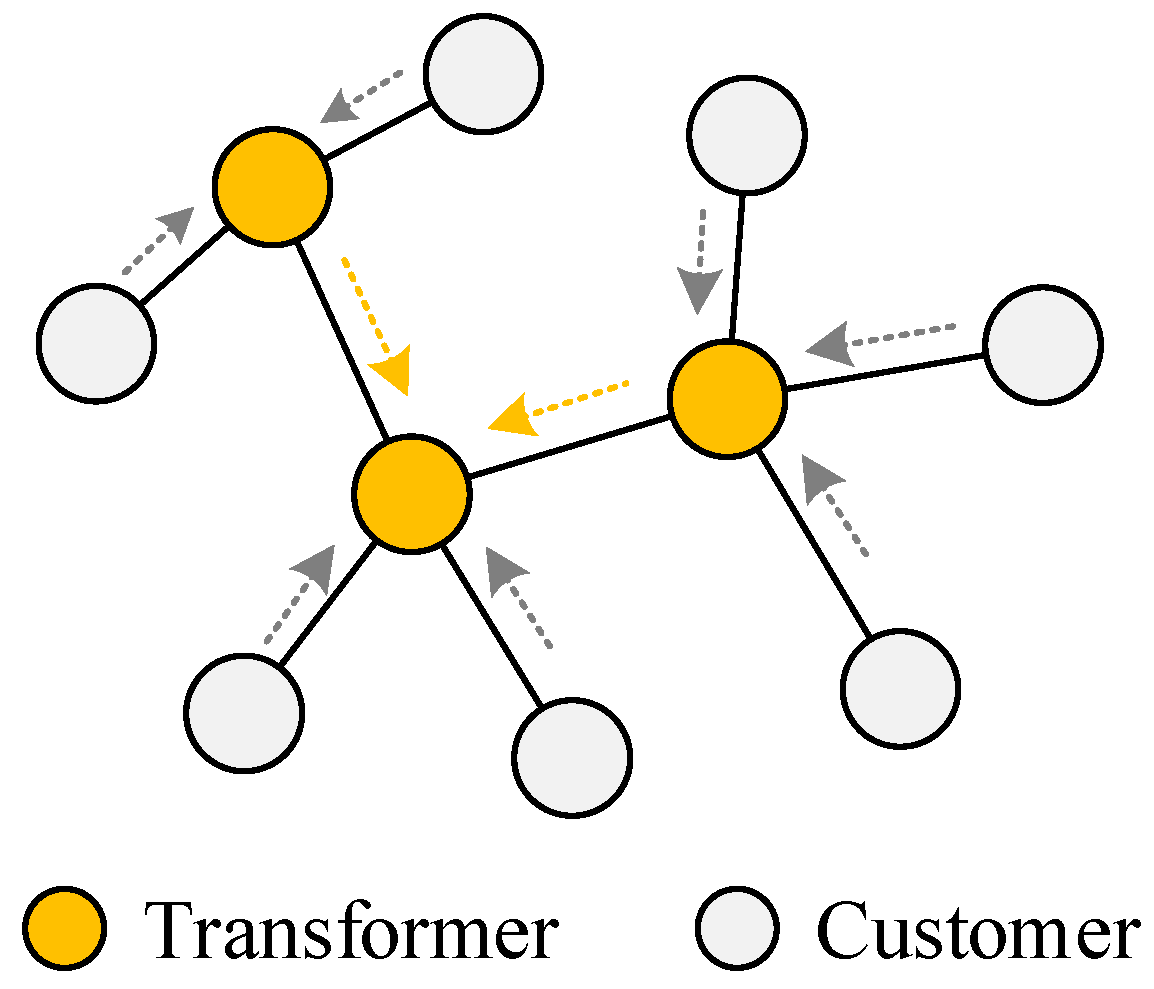
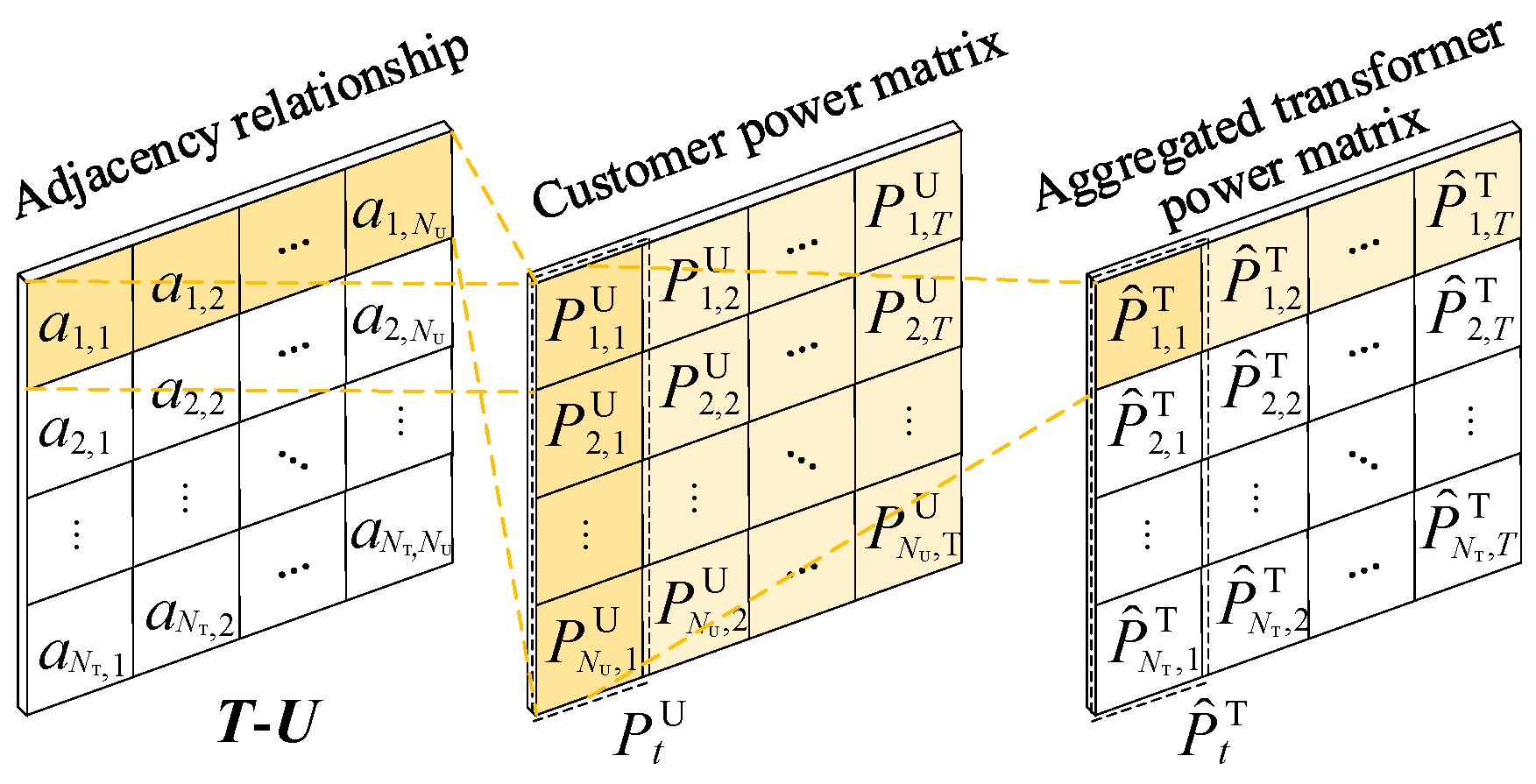
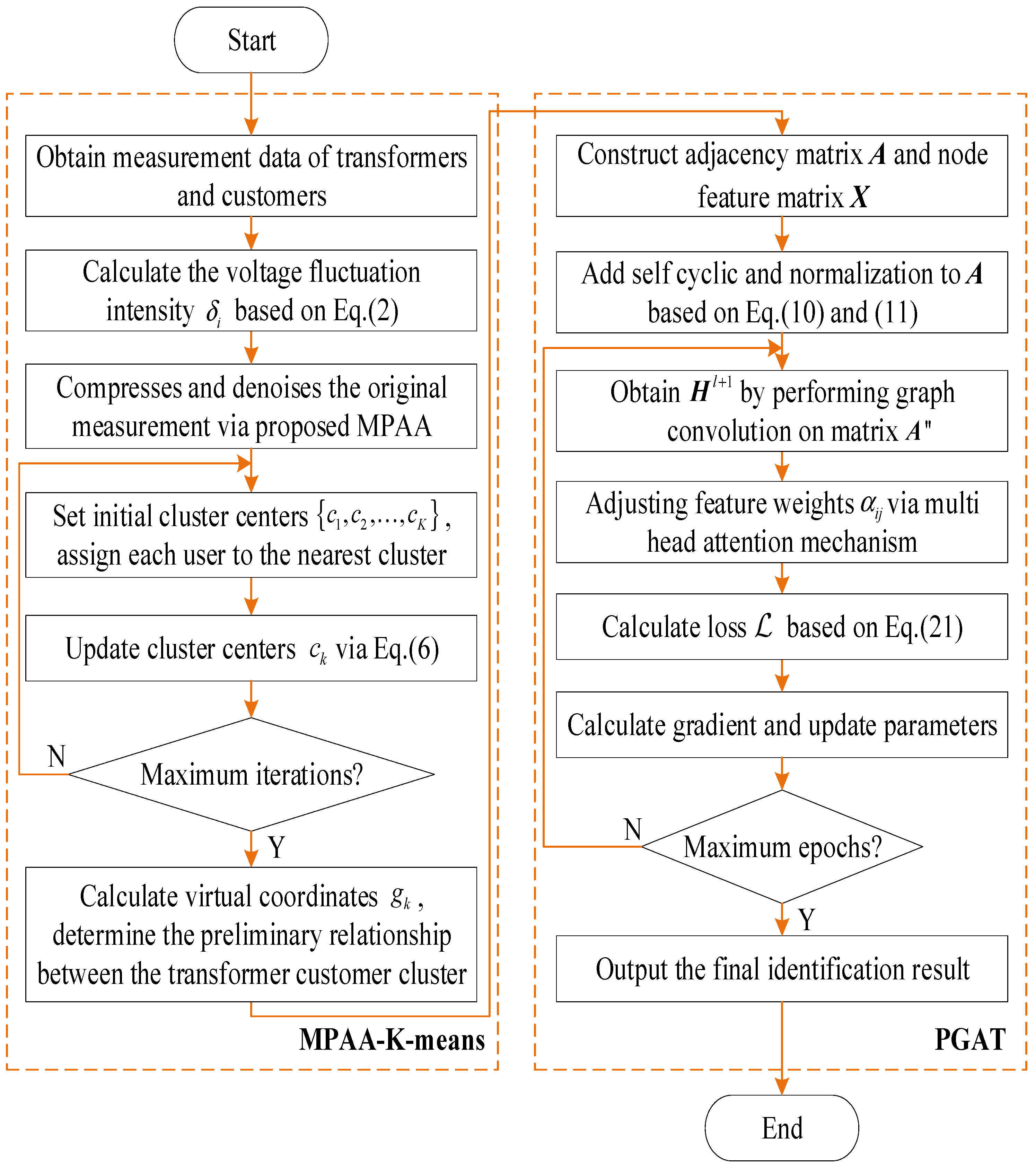


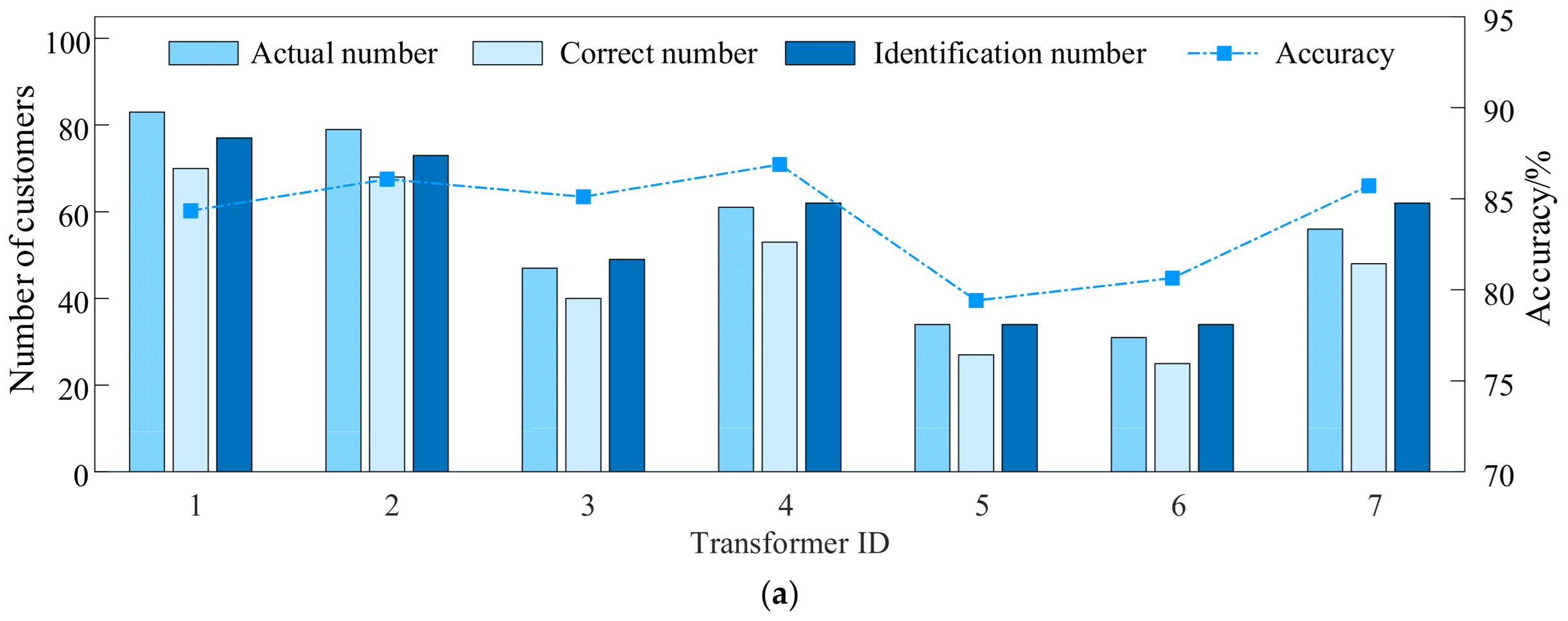
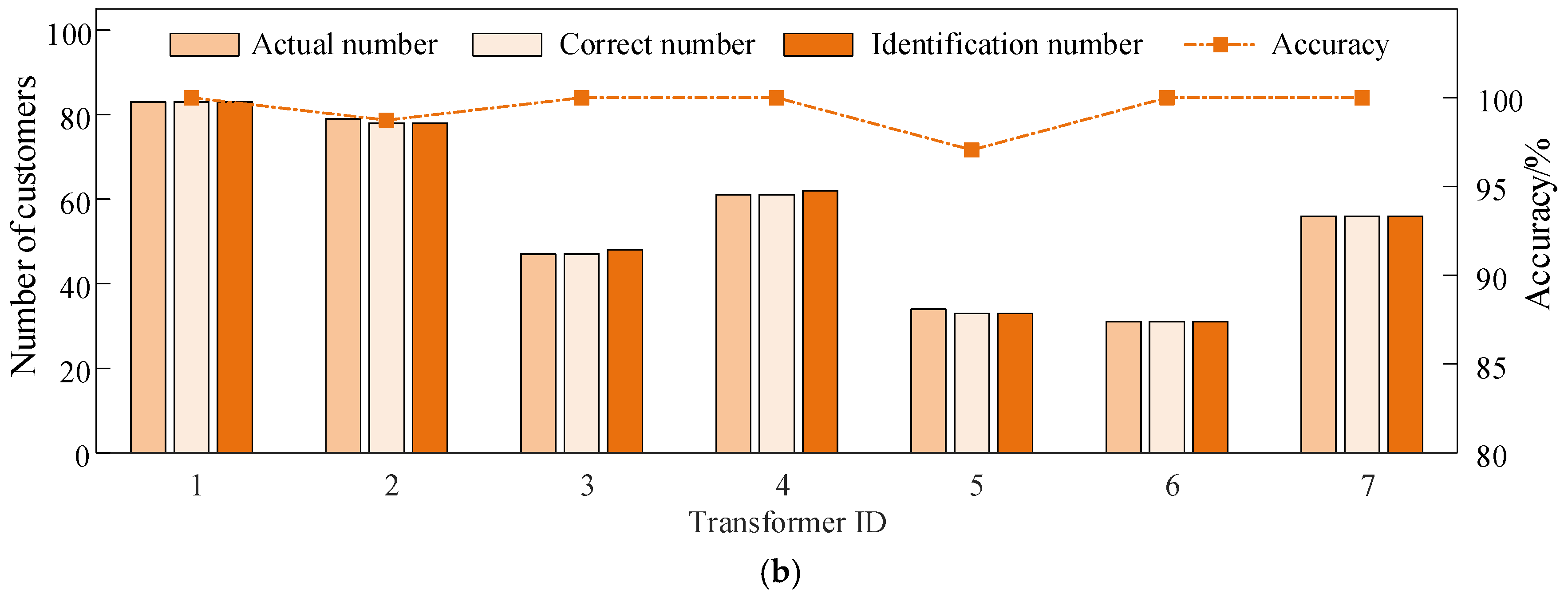


| Transformer ID | Number of Customers |
|---|---|
| 1 | 83 |
| 2 | 79 |
| 3 | 47 |
| 4 | 61 |
| 5 | 34 |
| 6 | 31 |
| 7 | 56 |
| Correctly Identified Household Count | Incorrectly Identified Household Count | Accuracy/% | |
|---|---|---|---|
| Method 1 | 316 | 75 | 80.82 |
| Method 2 | 331 | 60 | 84.65 |
| Method 3 | 368 | 23 | 94.12 |
| Method 4 | 389 | 2 | 99.49 |
Disclaimer/Publisher’s Note: The statements, opinions and data contained in all publications are solely those of the individual author(s) and contributor(s) and not of MDPI and/or the editor(s). MDPI and/or the editor(s) disclaim responsibility for any injury to people or property resulting from any ideas, methods, instructions or products referred to in the content. |
© 2025 by the authors. Licensee MDPI, Basel, Switzerland. This article is an open access article distributed under the terms and conditions of the Creative Commons Attribution (CC BY) license (https://creativecommons.org/licenses/by/4.0/).
Share and Cite
Lei, Y.; Yang, F.; Feng, Y.; Hu, W.; Cheng, Y. Two-Stage Transformer–Customer Relationship Identification Strategy for Low-Voltage Distribution Grid Using Physics-Guided Graph Attention Network. Energies 2025, 18, 4380. https://doi.org/10.3390/en18164380
Lei Y, Yang F, Feng Y, Hu W, Cheng Y. Two-Stage Transformer–Customer Relationship Identification Strategy for Low-Voltage Distribution Grid Using Physics-Guided Graph Attention Network. Energies. 2025; 18(16):4380. https://doi.org/10.3390/en18164380
Chicago/Turabian StyleLei, Yang, Fan Yang, Yanjun Feng, Wei Hu, and Yinzhang Cheng. 2025. "Two-Stage Transformer–Customer Relationship Identification Strategy for Low-Voltage Distribution Grid Using Physics-Guided Graph Attention Network" Energies 18, no. 16: 4380. https://doi.org/10.3390/en18164380
APA StyleLei, Y., Yang, F., Feng, Y., Hu, W., & Cheng, Y. (2025). Two-Stage Transformer–Customer Relationship Identification Strategy for Low-Voltage Distribution Grid Using Physics-Guided Graph Attention Network. Energies, 18(16), 4380. https://doi.org/10.3390/en18164380







